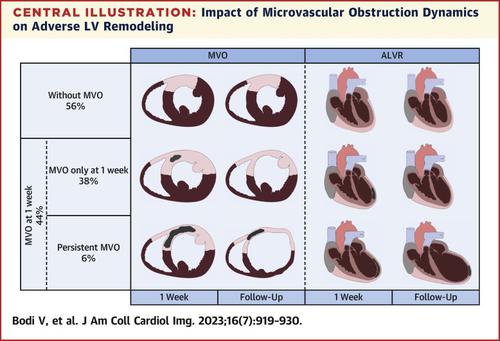JACC: Cardiovascular Imaging ( IF 12.8 ) Pub Date : 2023-04-12 , DOI: 10.1016/j.jcmg.2023.01.021 Vicente Bodi 1 , Jose Gavara 2 , Maria P Lopez-Lereu 3 , Jose V Monmeneu 3 , Elena de Dios 4 , Nerea Perez-Sole 5 , Clara Bonanad 6 , Victor Marcos-Garces 5 , Joaquim Canoves 6 , Gema Minana 1 , Julio Nunez 1 , David Moratal 2 , Francisco J Chorro 1 , Jose F Rodríguez-Palomares 7 , Andrea Freixa 8 , Roger Borrás 8 , Jose T Ortiz-Pérez 8 , Cesar Rios-Navarro 5

|
Background
Little is known about the occurrence and implications of persistent microvascular obstruction (MVO) after reperfused ST-segment elevation myocardial infarction (STEMI).
Objectives
The authors used cardiac magnetic resonance (CMR) to characterize the impact of persistent MVO on adverse left ventricular remodeling (ALVR).
Methods
A prospective registry of 471 STEMI patients underwent CMR 7 (IQR: 5-10) days and 198 (IQR: 167-231) days after infarction. MVO (≥1 segment) and ALVR (relative increase >15% at follow-up CMR) of left ventricular end-diastolic index (LVEDVI) and left ventricular end-systolic volume index (LVESVI) were determined.
Results
One-week MVO occurred in 209 patients (44%) and persisted in 30 (6%). The extent of MVO (P = 0.026) and intramyocardial hemorrhage (P = 0.001) at 1 week were independently associated with the magnitude of MVO at follow-up CMR. Compared with patients without MVO (n = 262, 56%) or with MVO only at 1 week (n = 179, 38%), those with persistent MVO at follow-up (n = 30, 6%) showed higher rates of ALVR-LVEDVI (22%, 27%, and 50%; P = 0.003) and ALVR-LVESVI (20%, 21%, and 53%; P < 0.001). After adjustment, persistent MVO at follow-up (≥1 segment) was independently associated with ΔLVEDVI (relative increase, %) (P < 0.001) and ΔLVESVI (P < 0.001). Compared with a 1:1 propensity score–matched population on CMR variables made up of 30 patients with MVO only at 1 week, patients with persistent MVO more frequently displayed ALVR-LVEDVI (12% vs 50%; P = 0.003) and ALVR-LVESVI (12% vs 53%; P = 0.001).
Conclusions
MVO persists in a small percentage of patients in chronic phase after STEMI and exerts deleterious effects in terms of LV remodeling. These findings fuel the need for further research on microvascular injury repair.
中文翻译:

STEMI 后持续微血管阻塞对不良左心室重构的影响:一项 CMR 研究
背景
关于再灌注 ST 段抬高型心肌梗死 (STEMI) 后持续性微血管阻塞 (MVO) 的发生和影响知之甚少。
目标
作者使用心脏磁共振 (CMR) 来表征持续 MVO 对不良左心室重构 (ALVR) 的影响。
方法
471 名 STEMI 患者的前瞻性登记在梗死后第 7 天(IQR:5-10)天和 198 天(IQR:167-231)接受了 CMR。确定左心室舒张末期指数 (LVEDVI) 和左心室收缩末期容积指数 (LVESVI) 的 MVO(≥1 节段)和 ALVR(随访 CMR 时相对增加 >15%)。
结果
209 名患者 (44%) 发生了 1 周 MVO,30 名患者 (6%) 持续存在。1 周时MVO 的程度(P = 0.026)和心肌内出血(P = 0.001)与随访 CMR 时 MVO 的程度独立相关。与无 MVO 的患者 (n = 262, 56%) 或仅在 1 周时出现 MVO (n = 179, 38%) 的患者相比,随访时持续存在 MVO 的患者 (n = 30, 6%) 的 ALVR 率更高-LVESVI(22%、27% 和 50%;P = 0.003)和 ALVR-LVESVI(20%、21% 和 53%;P < 0.001)。调整后,随访时持续 MVO(≥1 节段)与 ΔLVEDVI(相对增加,%)(P < 0.001)和 ΔLVESVI(P <0.001)。与仅在 1 周时由 30 名 MVO 患者组成的 CMR 变量 1:1 倾向评分匹配人群相比,持续性 MVO 患者更频繁地表现出 ALVR-LVEDVI(12% vs 50%;P = 0.003)和ALVR- LVESVI(12% vs 53%;P = 0.001)。
结论
MVO 在 STEMI 后慢性期的一小部分患者中持续存在,并对 LV 重塑产生有害影响。这些发现推动了对微血管损伤修复进一步研究的需要。






































 京公网安备 11010802027423号
京公网安备 11010802027423号